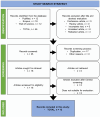A Scoping Review of Vitamins Detection Using Electrochemically Polymerised, Molecularly Imprinted Polymers
- PMID: 40430712
- PMCID: PMC12115226
- DOI: 10.3390/polym17101415
A Scoping Review of Vitamins Detection Using Electrochemically Polymerised, Molecularly Imprinted Polymers
Abstract
Vitamins are crucial micro-nutrients for overall well-being, making continuous monitoring essential. There are demands to provide an alternative detection, especially using a portable detection or a point-of-care-testing (POCT) device. One promising approach is employing an in situ electro-polymerised MIP (eMIP), which offers a straightforward polymerisation technique on screen-printed electrodes (SPEs). Here, we report a review based on three databases (PubMed, Scopus, and Web of Science) from 2014 to 2024 using medical subject heading (MeSH) terms "electrochemical polymerisation" OR "electropolymerisation" crossed with the terms "molecularly imprinted polymer" AND "vitamin A" OR "vitamin D" OR "vitamin E" OR "vitamin K" OR "fat soluble vitamin" OR "vitamin B" OR "vitamin C" OR "water soluble vitamin". The resulting 12 articles covered the detection of vitamins in ascorbic acid, riboflavin, cholecalciferol, calcifediol, and menadione using monomers of catechol (CAT), 3,4-ethylenedioxythiophene (EDOT), o-aminophenol (oAP), o-phenylenediamine (oPD), pyrrole, p-aminophenol (pAP), p-phenylenediamine (pPD), or resorcinol (RES), using common bare electrodes including graphite rod electrode (GRE), glassy carbon electrode (GCE), gold electrode (GE), and screen-printed carbon electrode (SPCE). The most common electrochemical detections were differential pulse voltammetry (DPV) and linear sweep voltammetry (LSV). The imprinting factor (IF) of the eMIP-modified electrodes were from 1.6 to 21.0, whereas the cross-reactivity was from 0.0% to 29.9%. Several types of food and biological samples were tested, such as supplement tablets, poultry and pharmaceutical drugs, soft drinks, beverages, milk, infant formula, human and calf serum, and human plasma. However, more discoveries and development of detection methods needs to be performed, especially for the vitamins that have not been studied yet. This will allow the improvement in the application of eMIPs on portable-based detection and POCT devices.
Keywords: eMIP; electrochemical detection; fat-soluble vitamin; in situ electro-polymerisation; water-soluble vitamin.
Conflict of interest statement
The authors declare no conflicts of interest.
Figures
Similar articles
-
Highly sensitive and selective electrochemical paper-based device using a graphite screen-printed electrode modified with molecularly imprinted polymers coated Fe3O4@Au@SiO2 for serotonin determination.Anal Chim Acta. 2019 Oct 24;1077:255-265. doi: 10.1016/j.aca.2019.05.047. Epub 2019 May 31. Anal Chim Acta. 2019. PMID: 31307717
-
Development of a molecularly imprinted electrochemical sensor for erlotinib detection using a modified screen-printed carbon electrode.Mikrochim Acta. 2025 Feb 10;192(3):138. doi: 10.1007/s00604-025-07012-4. Mikrochim Acta. 2025. PMID: 39930278
-
Molecularly imprinted sensor based on poly-o-phenylenediamine-hydroquinone polymer for β-amyloid-42 detection.Anal Bioanal Chem. 2023 Mar;415(8):1545-1557. doi: 10.1007/s00216-023-04552-7. Epub 2023 Feb 18. Anal Bioanal Chem. 2023. PMID: 36808273
-
Molecularly imprinted hornlike polymer@electrochemically reduced graphene oxide electrode for the highly selective determination of an antiemetic drug.Anal Chim Acta. 2021 Jan 2;1141:71-82. doi: 10.1016/j.aca.2020.10.014. Epub 2020 Oct 14. Anal Chim Acta. 2021. PMID: 33248664
-
Nanomaterial-assisted molecularly imprinted polymer strategies for highly sensitive and selective determination of cefdinir and its validation using computational approach.J Pharm Biomed Anal. 2024 Aug 15;246:116209. doi: 10.1016/j.jpba.2024.116209. Epub 2024 May 8. J Pharm Biomed Anal. 2024. PMID: 38759322 Review.
References
-
- Gupta U., Gupta S. Role of Vitamins in Human Health and Nutrition: Sources and Morbidity. Curr. Nutr. Food Sci. 2015;11:105–115. doi: 10.2174/1573401311666150429225548. - DOI
-
- Hoque M., Emon K., Malo P.C., Hossain M.H., Tannu S.I., Roshed M.M. Comprehensive Guide to Vitamin and Mineral Sources with Their Requirements. Indiana J. Agric. Life Sci. 2023;3:23–31. doi: 10.5281/zenodo.10284736. - DOI
-
- Bhalla T.C. Industrial Biotechnology of Vitamins, Biopigments, and Antioxidants. Wiley; Hoboken, NJ, USA: 2016. Savitri Vitamin B3, Niacin; pp. 41–66.
Publication types
Grants and funding
LinkOut - more resources
Full Text Sources
Research Materials
Miscellaneous




